An Ode to Expertise: What have we learnt from COVID and how can we apply our new learning?
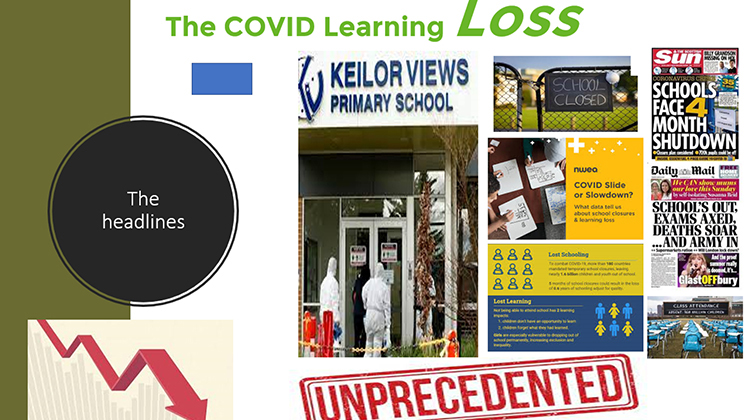
In 2020, Victorian students were not physically in- school for about 120 days – half the school year. Teachers have now been asked five times to switch from in-school to COVID-teaching, which includes distance, hybrid, and then back to all in school. While early days, the research evidence about the impact of COVID teaching is beginning to emerge. But to start, let’s set the scene by looking backwards, and develop a baseline of schooling in pre-COVID in- school classes.
1 Looking Back
The normal policy environment involves schools receiving edicts from on-high about how to teach, assess, and be accountable for teaching. But it is hard to find, around the world, a single document that has helped schools adjust to Covid teaching. Instead, educators have worked out to maximize learning, minimize disruption, deal with social and emotional learning, deal with the watchful eyes of many parents, and maintain their own mental health and work-life balance. COVID teaching has truly been the greatest educator-led revolution in our lifetime. We have much to learn how to capture the policy ideas from schools and fed and scale up these ideas – and not return to the predominantly top down policy environment.
To evaluate the effects of COVID teaching, it is necessary to outline the grammar of schooling that dominates the usual in-class teaching. While there are many variants of this grammar, it also has led to many of the successes we now have in our schools. It serves many of our students but leaves too many behind or allowed to drop out of learning even though they are physically present. Much of this evidence comes from our analyses of transcripts of about 16,000 classrooms (https://visibleclassroom. com/), from the pioneering work of Cuban and Tyack (1995), and many other classroom observation studies (e.g. , Antonetti & Garver, 2015).
Schools sort, label, and group students, ask them to leave their family and culture at the school gate, and invite parents to contribute to the school (PTA, fundraising), oversee homework, and receive biannual or annual school reports. Based on an analysis of many hundreds of school reports, we found that 98% of students were achieving well, putting in an effort, and a pleasure to teach. Such public relations disasters led to many parents asking for more and different (Hattie & Peddie, 2003).
In classes, teachers talk a lot (ave = 89%), ask 120-160 questions with 90%+ requiring less than 3 words in response, talk fast (ave = 174 words a minute; primary students speak 124 wpm), and talk about 1.5 years above the grade level. When we ask students to describe a good learner, they too often say ‘a student who comes to class prepared, sits up straight, and watches the teacher work’. A class of students ask about 11 questions per class – 9 about the process (what page are we on) and 2 about their understanding. They hear teachers talking, but rarely do teachers hear students thinking aloud, and classes are dominant 80:20 surface (content, ideas, knowledge) to deep (relations, transfer). Lessons are full of activities, much ‘do-ing’ – and in a lot of ‘doing’ there can be little learning. Students sit in groups and work alone, learn to look like they are listening, and are taught that mistakes illustrate their lack of ability and errors show their lack of attention to the teaching. Assessments are too often seen as end points, emphasize achievement over progress, lead teachers to predominantly provide ‘how am I going?” feedback, and seen as motivators to invest in the work.
The introduction of technology has been occurring since the mid 1970’s and from over 240 meta-analyses shows the average effect-size has barely changed from .20-.40, despite exponential growth in the power and availability of technology.
Social and emotional learning has always been part of teaching and learning, and while schools can be safe havens for students, they can also be lonely places, where bullying, isolation and racism can be nasty. Pre-COVID, the best estimate I can find for the percentage of students suffering major depression, anxiety and loneliness is about 10% of students.
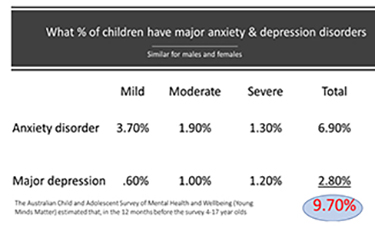
2 What Happened?
Victorian schools experienced among the longest lockouts in the world, with now 5 lock outs totalling about 120+ days – almost 60% of a school year. The headlines are negative and depressing, the many studies using projection methods full of doom and gloom (e.g., Bailey et al. 2021 projected a loss of 1.00 to 1.30 for mathematics and 1.25 for reading). The dominant phrase is ‘learning loss’, well-being losses, and students turned off learning. There is always an industry that wants to proclaim doom and gloom, and so many want to profit from pushing their advocacy into the schools arena.
3 Evidence of Impact
I wish to use 7 studies relating to academic effects and 7 studies relating to social and emotional learning, and a major message is “do not presume”. Do not presume that the ‘usual’ groups of students with learning difficulties, with equity or well-being issues, the naughty and the disengaged are necessarily positively or negatively impacted from COVID teaching. The flaw of the average, the vicious inequities of classifying students into categories can lead to major misinterpretations, and COVID should make us seriously question any low expectations, any use of seeing students as part of a group, and instead we need to privilege the centrality of each student.
Achievement Effects
1 Zierer (2021) has completed the first meta-analysis of 7 European studies based on 5m+ students. The average effects were: primary school -.17, high school -.10, mathematics -.17, native language -.11. These are small but important effects showing that distance learning is not optimal so any claims that schools should stay in COVID mode teaching would be hard to defend. The key question is to learn about what did and did not work well, focus on the rebound, and accelerate the rate of learning when returning to regular in-class schooling. This low negative effect indicates that rebounding is highly likely – provided we ‘do not presume’ and have deliberate strategies to accelerate – as we should every year.
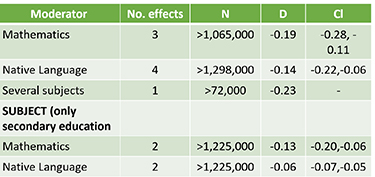
2 The OECD systematic review (Hammerstein et al. 2021) found similar effects: overall -.10, mathematics
= -.12, reading = -.14. They argued that these effects were not too different from the usual ‘summer loss’ although the effects were slightly more negative for younger children and children from families with low socioeconomic resources. The schools with (slightly) positive effects all used some systematic online learning software and did not aim to ‘replicate’ the in-class teaching.
3 New Zealand has a unique school assessment model (e-asttle.education.govt.nz/), whereby teachers can access a web based site to develop tests relative to what aspects of the NZ curriculum they are teaching, administer the test, and immediately get reports to advise them about next learning steps. It is voluntary, and 60-70% use the tool (usually 2-4 times a year) and this has been occurring over the past 20 years (Hattie et al., 2006). Webber (2021) used the data from 5m+ students to compare the gains made in 2020 to each of the previous ten years. There were slight drops in Reading, slight gains in Mathematics, and major drops in Writing. The conclusion was that
“the learning impact may not be as widespread as expected. That’s a credit to educators, parents and whanau for their flexibility and support, and to the resilience of learners themselves.” Learning did not stop.
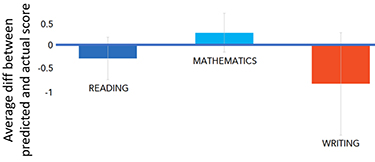
4 In NSW, Gore (2021) compared performance in 2019 and 2020 for 1,300 Year 3 and 4 students from 113 schools and concluded that “somewhat surprisingly our analysis found no significant differences between 2019 and 2020 in student achievement growth as measured by progressive achievement tests in mathematics or reading”. The effects were slightly more negative in lower SES schools and the article ends noting that “these findings are a testament to the dedicated work of teachers during the 2020 pandemic to ensure that learning for most students was not compromised, despite unusually trying circumstances”.
5 Victoria has produced the most impressive reviews of what occurred during the lockdown (based on the lengthiest lockdown in 2020). Jensen (2020) used data from 60+ schools internal surveys; surveys from 2,316 parents, 513 teachers, 206 school leaders, 150 students, 15 peak association representatives; parent and Student Learning From Home Surveys of 20,240 students from 188 schools and 12,160 parents from 234 schools; weekly school leader surveys (N=1033) conducted by the Department and their regional offices; 49 workshops and focus groups with school leaders, students, teachers, Senior Education Improvement Leaders in the Department, parents; and administrative data sets the Department collects on student absenteeism and other issues such as teacher and school leader well-being (https://learningfirst.com/wp-content/uploads/2020/09/Remote-and- Flexible-Learning-LF-Final-report-Sep.pdf).
The major messages related to how school leaders, teachers, students, and parents rallied to meet the challenge head-on. School attendance rates remained high – the vast majority of students took part in remote and flexible learning every day. Morale also stayed high, in the main, as teachers and school leaders worked together to address difficult dilemmas with a sense of mutual respect and common purpose. Parents gained unprecedented insight into their children’s education and school, bringing potential benefits for years to come. New skills were acquired; new pedagogical opportunities trialled. It was notable that many students found online learning more efficient, that students who are normally shy and quiet in class spoke up and contributed more in the online environment and that many were more engaged in learning. There was more trimming of content coverage to allow for depth, and that most assessments administered in-class did not apply and new methods of evaluating the impact of teaching and the learning of students had to be invented. Students claimed many benefits and noted some of the negative effects.
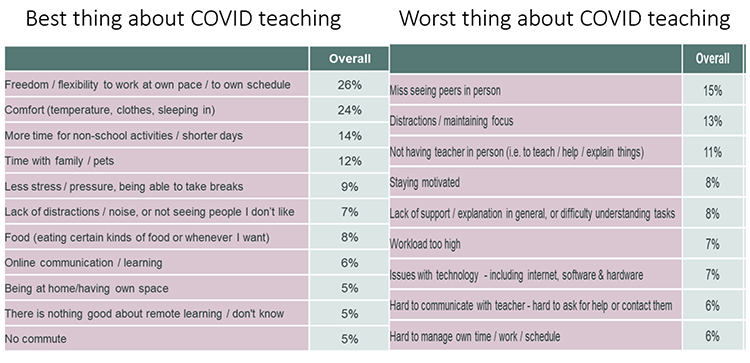
6 Teachers in two Australian secondary schools published their experiences: one school with extensive COVID-teaching and one remaining in-class (n=834 students; Patston et al., 2021). They found that similar levels of positive attitudes toward learning, similar levels of difficulty, anxiety, and higher levels of creativity within the COVID and in-school classes. This, they argued “speaks to the resilience and flexibility of the students in adapting to new modalities of pedagogy and independent learning” (p. 11).
7 Much angst was expressed about the effects of those students engaged in high stakes exams, particularly for those wanting access to high demand university courses. Among the more overused words to describe 2020 is ‘unprecedented’, which surely reflects a lack of knowledge about history (Ferguson, 2021). There is much previous research on the effects of floods, earthquakes, wars, and strikes on these exams. For example, following the Christchurch earthquake, the performance of final year students went up compared to previous years (and reverted within 2 years back to pre-earthquake levels, Ero, 2012). In the Victorian VCE exams, performance was relatively stable in terms of exam and study score outcomes compared to VCE performance in 2019 (and in previous years); and for the 2020 English exam (for example, the largest VCE study), the mean percentage scores were approximately 55% in 2017, 55% in 2018, 53% in 2019 and 56% in 2020.
Overall, the effects on achievement were small negatives. Yes, COVID teaching is not optimal, and on average and students learning trajectories were slightly lower than in previous years, but much learning still occurred. It is improper to use the word “loss” as that implies learning was missing, went backwards, and this is just not correct. Further, promoting negative stories about learning loss undermines the incredible expertise, effort, efficiencies, and effectiveness of teachers, leaders, and students (and many families) to ensure that learning continued almost at the same levels of growth as previous years in-class teaching. There is no cause for complacency, but much to celebrate about educators success during COVID.
Social Emotional Learning
There have been similar stories of crisis and angst about the marked effects of social and emotional learning (SEL). There is no doubt there are negative COVID effects due to death, illness, unemployment, and access. No one asked for, or wants COVID. So what is the emerging evidence about the effects on SEL. Again, 7 studies.
1 Using 204 meta-analyses in the Visible Learning data base (No. studies =12,000+, there is major variance of the many SEL influences – from -.80 to .60 (ave = .10). The major SEL influences on achievement related to having a sense of efficacy that you can successfully complete the task, using one’s motivational resources to want to go beyond the facts to see relations and deeper conceptual understanding, and being highly engaged in the learning. The negative strong delimiters are anxiety and frustration, surface motivation (just doing the work, passing the tests, doing better than some others in the class), and boredom (see https:// www.visiblelearningmetax.com).
2 I am part of a team led by Houghton et al. (in review) studying the differences in adolescents experience of loneliness compared to aloneness (being comfortable being alone). We had planned a 4 phased time series study, but after the first two surveys (4 months apart) along came COVID. The third set of data came during lockdown, and the fourth after the end of lockdown (N=785 adolescents). Relative to the baseline (the two pre-COVID times), the average depression scores went up (d = .10), and well-being went down during lockdown (-.11) but snapped back to pre-COVID levels when students came out of lockdown and back to regular schooling.
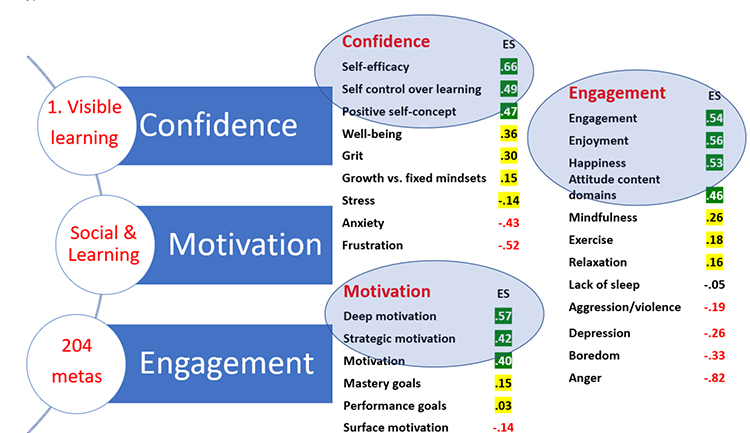
There are claims that those students who were already predisposed to the most elevated levels of depression and lowest levels of well-being could be differentially affected to a much greater extent. The opposite may be the case – those with very high levels of depression pre-COVID decreased their levels of depression and those with the lowest levels of well-being improved during COVID, and seemed to maintain these levels after lockdown.
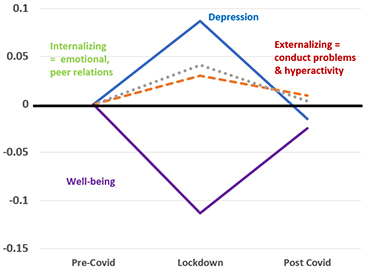
3 Magson et al. (2021) investigated the effects on 248 adolescents feelings of isolation pre and during COVID teaching. Their results showed that adolescents were not overly concerned with the impact that COVID-19 was having on their education or their health, but more concerned about friendship issues.
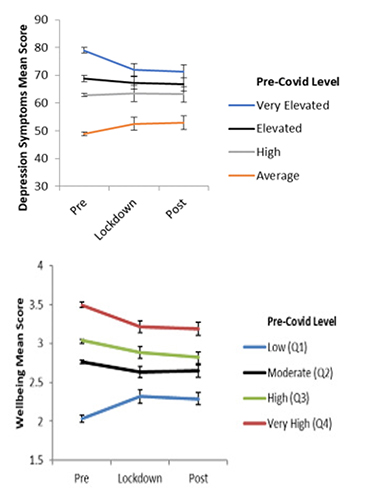
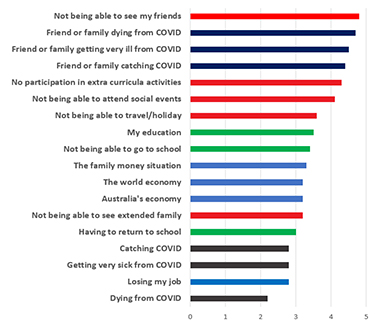
4 Pirkis et al. (2021) sourced real-time suicide data from 21 countries between Sept 1 and Nov 1, 2020, and compared these rates to trends before this time. The rates decreased in most countries, and this could be because additional mental health supports and financial safety nets were introduced. Similarly, a review by the Lancet Commission concluded that there is a clear and consistent body of evidence that suggests that psychological distress increased during the early months of the COVID-19 pandemic and that most (but not all) facets returned to pre-pandemic levels by mid-2020 (Aknin, et al., 2021). They also noted lower levels during COVID of self-harm, increases in emotional well-being, little overall change in social connection and loneliness, and a significant increase in perceptions of social support.
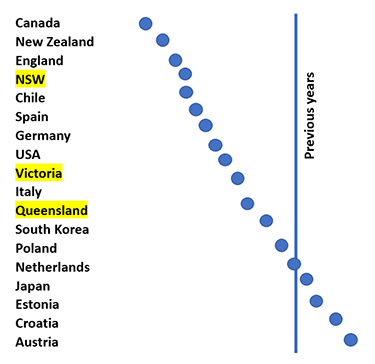
5 The Flourish movement is based in NSW, and they generously provided data about the effects of COVID on school principals, teachers, and parents (https://www.theflourishmovement.com). Across 603 principals pre and 142 post, and 1116 teachers pre and 591 post Covid, they all claimed there was an increase in social and supervisory support (leaders for teachers, SEILs for leaders). Principals experienced fewer interruptions and this reflected their change in role in supporting their teachers more, and there were increases in principal well-being, psychological capital, work-family balances and recovery at home and work. Teachers claimed more overload and recovery at home. There were no differences in stress or flow for both principals and teachers. In a separate study, from 294 teachers in 9 schools, there were overall high ratings for levels of communication, quality and support of leadership, and work culture.
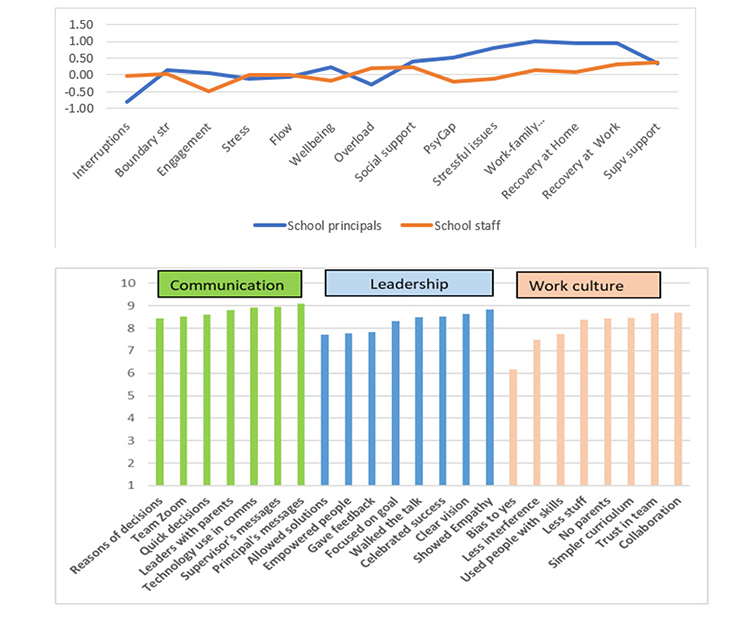
6 Verso is a Victoria based app that permits students to comment on their feelings, gives them a voice in the classroom, reflect about their thinking and self- reflection skills (https://v2.versoapp.com/). They also generously provided their data and reports. One of the reports asks ‘How they are feeling during the lesson’, and across 1520 students a Wordle was created to depict the major feedings pre and during COVID. The same one word dominated in both contexts: boredom. A major cause of boredom is lack of challenge in the activity, and when asked about the level of challenge in lessons, students rated them at very low levels of challenge.
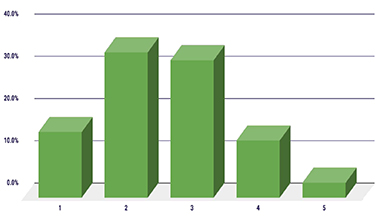
During COVID teaching, 69% of students were ‘doing well’ or ‘flourishing’, 14% were ‘struggling’, and 6% were ‘distressed’. There is a facility for students to indicate if they ‘wanted catch-up with their teacher to discuss how they were feeling’. While the evidence so far shows that it is highly likely that the same proportion is the case with in-class teaching, one of the advantages of online learning is that students are more likely to indicate their wish to follow up – which happens much more rarely in the class, if for no other reason than the reactions of other students.

What is fascinating is that 63% of students who were unsure what they were learning had the lowest levels of well-being in the class. But when compared to classes where students could clearly explain what they are learning there was a complete flip with 64% of the students expressing positive well-being.
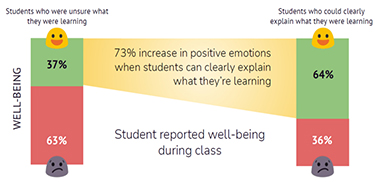
7 As part of an OECD survey of principals and educational administrators across 59 countries, Reimers and Schleicher (2021) found there was “remarkable resilience, flexibility, and commitment to education in having established strategies for education continuity, in extremely challenging conditions, during the Covid-19 pandemic”. For the most part, those strategies were viewed positively by senior administrators, teachers, and school and other education administrators, in terms of their implementation and the results they achieved in providing a considerable number of students access to at least part of the curriculum.
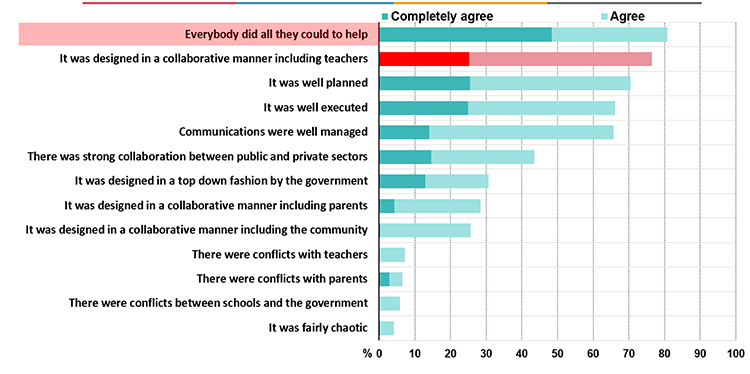
4 Looking Forward
A fundamental question is ‘Why has the learning trajectories only marginally decreased during COVID teaching, and levels of well-being, anxiety, depression etc. increased marginally but snapped back once schools came out of lock down?’. Contrary to expectations, forecasters, and purveyors of doom there were remarkable levels of resilience, coping strategies, and expertise that minimized the harm – indeed added very high levels of value-added growth during COVID teaching. Why? There can but be only one answer: The expertise and commitments of educators. It is their expertise to pivot (sometimes overnight), invest high levels of workload and skill, caring at the very highest levels for the well-being and learning lives of their students.
Parents soon saw these high levels of expertise as they battled with their 1–3 precious learners, and many struggled to maintain engagement. Then the realization – teachers engage 100–200 students (in high schools) a day, for 200 days a year. And they do more than engage – they teach, they care, they motivate, they assess, they improve their own learning to maximize their impact on students. This is surely the time to stand up and not deny educator expertise, but scream to all voters, politicians, reporters, and parents that we need to invest in this expertise. Indeed, we have argued that the essence of our profession is this expertise (which we anchor in the notion of evaluative thinking, Rickards et al. 2021).
There are many major positives on how teaching occurred during COVID times. It was soon discovered that teaching according to the old Grammar of Schooling just would not work. On-line it was not possible to talk 89% of the time, nor use surveillance to ensure students were ‘doing’ the work. Teachers had to switch to more of a triage approach – listen to where students were, what they were struggling with, giving feedback as ‘where to go next’, make lessons more like a ‘short story’ that had a beginning, middle and end, be clear about what success looks like as they start a series of lessons. Triage involves considering the efficiencies as well as the effectiveness of lessons (many students commented that could complete their school work in a fraction of the time compared to in-class teaching). Teachers had to gradually release responsibility and slow down on teaching and speed up on learning, create opportunities to hear more student error and mistakes and see these as opportunities to learn (using many of the features of social media, like chat rooms), there was much more attention to the Goldilock’s principle of challenge (not too hard, not too easy, and not too boring), and integration of SEL about learning within lesson planning and delivery. It is time to take these learnings back into the regular classroom.
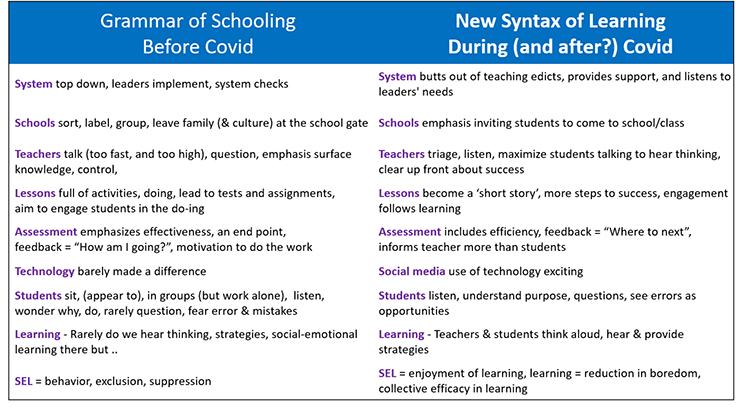
It is important to be clear about what ‘SEL’ denotes, and there needs to be much resistance to now asking teachers to become counselors. We need to work out how to work with teachers to identify those students needing follow up, and using specialists to assist teachers to learn about methods to totally engage and teach these students (e.g., using principles of Response to Intervention). SEL for the majority of students relates to boredom, which can be the precursor to many negative effects (such as depression anxiety, etc.; Westgate, 2020). Further, boredom is something teachers can and should fix.
There is a tendency right now to ‘look back’ with little appreciation that we are in the second year of the 2020–2030 decade, and thus need to reverse direction and look forward. The tragedy will be looking forward and ignoring many of the positive effects of COVID teaching. We have discovered that learning is not a place but an activity, learning is about coverage of less content to allow time to go deeper, engagement in learning is more than the do-ing, students need to be taught to become their own teachers (often referred to as self-regulation), the social media aspects of technology are exciting, social and emotional learning is about engagement in learning and motivating students to go beyond the facts and thus reducing boredom, students and educators are mightily resilient, we need to learn from the very high levels of teacher and leader collective efficacy that was apparent during COVID, add efficiency as well as effectiveness as positive markers of success, and esteem the expertise of educators.
It is worth every school taking time to invite all teachers and school leaders (and students and parents) to write a one page list of all the positives and the negatives from COVID teaching and use this in professional learning communities to reinvent the New Syntax of Learning - building on the old grammar but taking the findings from the disruption to bring back wiser. I did this with a group of teachers recently and they provided a powerful list. Imagine what wisdom could come from the profession doing this within each school, then across schools – and using this as the first post-COVID example of educators informing policy.
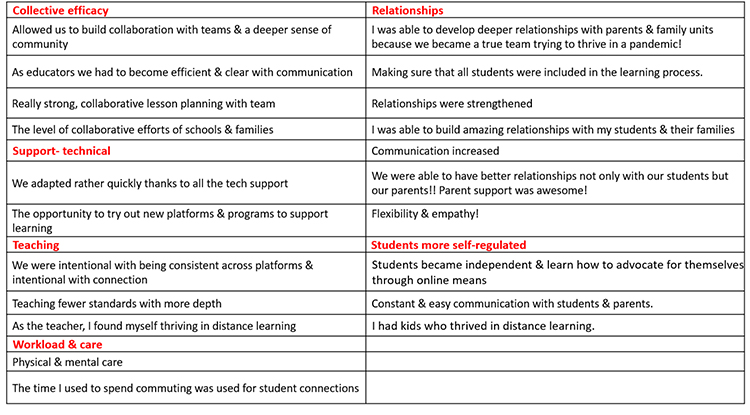
My COVID days were spent writing 4 playbooks for COVID teaching, and 2 playbooks for then Rebounding back to the regular classes taking the best of COVID learning to develop the new Syntax of learning.
Yes, there were negatives – there was death, sickness, unemployment; there were anxieties, depression, loneliness; there were many equity issues of access; homes were not always safe havens; workload and expectations on teachers increased; uncertainty and unpredictability became the norm. Yes, care is needed about extrapolating these claims to countries other than Australia – where there were equity issues with access to technology, and political fear and division about handling of COVID. Yes, the lockouts are not over (as I write this Victoria has gone into its 6th lockdown) and shorter lockdowns may not have the same effects as the longer ones. The major message here is that the community needs to honour the expertise, esteem the care and investment, and applaud the excellence of educators. Along with nurses and doctors, teachers are among the true heroes of COVID.
Australians have experienced many disasters such as fires, floods, and cyclones. Once again with COVID there is much evidence of resilience, getting on to solve problems, and looking after and helping each other. Educators have shown these attributes hence an Ode to their Expertise.
References
Aknin, L., De Neve, J. E., Dunn, E., Fancourt, D., Goldberg, E., Helliwell, J. F., Jones, S.P., & Ben Amor,
Y. (2021). Mental health during the first year of the COVID-19 pandemic: A review and recommendations for moving forward. Perspectives on Psychological Science.
Antonetti, J. V., & Garver, J. R. (2015). 17,000 classroom visits can’t be wrong: Strategies that engage students, promote active learning, and boost achievement. ASCD.
Bailey, D. H., Duncan, G. J., Murnane, R. J., & Au Yeung, N. (2021). Achievement Gaps in the Wake of COVID-19. Educational Researcher, 0013189X211011237.
ERO Review (2013). Stories of Resilience and Innovation in Schools and Early Childhood Services Canterbury Earthquakes: 2010-2012. https://ero.govt. nz
Ferguson, N., (2021). Doom: The Politics of Catastrophe. Penguin.
Hattie, J.A.C., & Peddie, R. (2003). School reports: “Praising with faint damns”. Set: Research information for teachers, 3, 4-9.
Hattie, J.A.C., Brown, G., Ward, L., Irving, E., & Keegan, P. (2006). Formative evaluation of an educational technology innovation: Developer’s insights into assessment tools for teaching and learning. Journal of Multidisciplinary Evaluation, 5(3), 1-54. http://tinyurl.com/28yxuc
Houghton, S., Kyron, M., Hunter, S., Lawrence, D., Hattie, J.A.C., Carroll, A., & Zadow, C. (in review). Longitudinal Trajectories of Loneliness and Mental Health Among Western Australian Adolescents: The Impact of the COVID-19 Pandemic.
Jensen, B. (2020). The experience of remote and flexible learning in Victoria. Victoria Department of Education.
Magson, N. R., Freeman, J. Y., Rapee, R. M., Richardson, C. E., Oar, E. L., & Fardouly, J. (2021). Risk and protective factors for prospective changes
in adolescent mental health during the COVID-19 pandemic. Journal of Youth and Adolescence, 50(1), 44-57.
Patston, T. J., Kennedy, J., Jaeschke, W., Kapoor, H., Leonard, S. N., Cropley, D. H., & Kaufman, J. C. (2021). Secondary Education in COVID Lockdown: More anxious and less creative—Maybe Not?.
Frontiers in Psychology, 12, 391, 1-14. doi: 10.3389/ fpsyg.2021.613055
Pirkis, J., John, A., Shin, S., DelPozo-Banos, M., Arya, V., Analuisa-Aguilar, P., ... & Spittal, M. J. (2021).
Suicide trends in the early months of the COVID-19 pandemic: an interrupted time-series analysis of preliminary data from 21 countries. The Lancet Psychiatry, 8(7), 579-588.
Reimers, F.M., Schleicher, A. (2021). How the Covid-19 pandemic is changing education. Global Education Innovation Initiative, Harvard Graduate School
of Education. https://globaled.gse.harvard.edu/ education-and-covid-19-pandemic
Rickards, F., Hattie, J.A.C., & Reid, C. (2021). The Turning Point for the Teaching Profession: Growing Expertise and Evaluative Thinking. Routledge.
Tyack, D. B., & Cuban, L. (1995). Tinkering toward utopia: A century of public school reform. Harvard University Press.
Webber, A. (2021). Student learning during COVID-19: Literacy and maths in Years 4-10. Education Insights. https://www.educationcounts.govt.nz/publications/ series/he-whakaaro
Westgate, E. (2020). Why boredom is interesting. Association for Psychological Science, 29(1), 33-40. https://journals.sagepub.com/doi/ full/10.1177/0963721419884309
Zierer, K. (2021). Effects of Pandemic-Related School Closures on Pupils’ Performance and Learning in Selected Countries: A Rapid Review. Education Sciences, 11(6), 252, 1-12. https://doi.org/10.3390/ educsci11060252
Professor John Hattie is an award-winning education researcher and best-selling author with over 40 years of experience examining what works best in student learning and achievement. His most recognized work is his Visible Learning research, the culmination of over 25 years of examining what works best for student learning and achievement.
Over the years, he has authored over 38 books, published and presented over 1200 research papers, supervised over 200 theses students to completion, and keynoted at more than 350 conferences.
Currently, he is Laureate Professor at the University of Melbourne, and Chair of the Australian Institute of Teaching and School Leaders.
Professor Hattie has been the recipient of the Hedley Beare Award for Writing in Education (ACEL), AERA Outstanding Reviewer for Educational Research, University Teaching and Supervision Award, Inaugural Secondary Principals Association Leadership in Education Award, Computerworld Excellence Award for Use of IT in Education, and he was elected Fellow of the American Psychological Association as well as Highly Commended in the BearingPoint Awards for Innovation in Technology. He has also been awarded with the “Order of Merit for New Zealand” for services to education by the NZ Government.